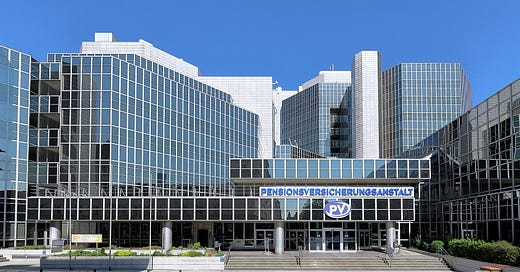Pension Plan
Austria's government has agreed a sustainability mechanism for the country's pension system that could see the statutory retirement age go up

Servus!
Earlier this month, the coalition of the conservative People’s Party (ÖVP), center-left Social Democratic Party (SPÖ), and liberal NEOS concluded negotiations over a ‘sustainability mechanism’ for Austria’s pension system. The three parties had already agreed to save €2.5 billion through reforms to the pension system, creating a budgetary glide path to lower pension spending. Should pension expenditures exceed this glide path by 0.5 percent by 2030, however, the sustainability mechanism would compel the (next) government to introduce additional measures to bring down Austria’s pension costs.
Before I talk about what the government has done, perhaps I should explain as best I can how Austria’s pension system currently works. The system is dominated by state pensions to which working people and their employers contribute via their paychecks. A person requires 15 years of pension contributions to receive some sort of state pension later in life; the full or maximum contribution span is 45 years. The higher a person’s pension contributions over their working life, and the longer they pay into the system, the larger their pension will be upon retirement1. The statutory retirement age in Austria is 65 for men and 61 for women, though by 2033, the retirement age for women will also be 65.
Much like with Social Security in the United States, there are benefits to delaying taking your pension and downsides to taking it early in certain circumstances. For every year a person waits to take their pension up to the age of 68, the size of their pension benefit increases by 5.1%. If a person chooses to take their pension early with only 40 years’ worth of contributions, they will be penalized to the tune of 5.1% for every year they retire before the statutory retirement age. (If you have 45 years of insurance contributions, then there are two pathways to early retirement that don’t result in penalties.)
In an attempt to save €2.5 billion, here’s what the government has done so far to reform the pension system. First, it has narrowed that aforementioned pathway to early retirement short of a full set of contributions. As of next year, a person will need 42 years’ worth of pension contributions get what’s called a ‘corridor pension,’ and the earliest they’ll be able to do it is at 63 years-of-age. (The penalties still apply.) Second, the government will introduce the concept of a ‘partial pension,’ which will allow people who were considering taking early retirement to claim only part of their corridor pension while working part-time and making further pension contributions. Call it semi-retirement, if you will.
Should these measures prove insufficient in lowering the deficit, that’s when the sustainability mechanism should kick in. The first course of action—again, for the next government, and not this one—will be to further tighten eligibility requirements for a corridor pension, with the number of years of required insurance contributions rising in increments of 0.5 from 2035 onwards (which, in terms of enforcement, would be a matter, not for the next government even, but the one after that). Thereafter, future governments would have a number of tools at their disposal—up to and including raising the statutory retirement age.
The sustainability mechanism has a whiff of can kicking about it, and that final step—raising the statutory retirement age—would be a deeply unpopular one with the voting public. Presently, only the NEOS and business interests like the Federation of Austrian Industries are in favor2. Raising the statutory retirement age is a step many European countries have already taken; the eligibility age for Social Security is 67, and further increases in the near future are entirely foreseeable. At some point, with life expectancy increasing, the labor market still relatively tight, pension costs as a share of the annual budget going up, and the interest on the national debt needing to be serviced, raising the statutory retirement age in Austria may, like a proctological exam, prove necessary if unpleasant.
Bis bald!
Thank you for reading The Vienna Briefing. Nothing beats a personal recommendation; if you know someone who would be interested in reading this newsletter, consider sharing it with them today.
The Vienna Briefing is a reader-supported publication. Your one-time or monthly tips make my work on this newsletter possible and help keep The Vienna Briefing free for everyone.
Gewessler Wears The Crown
Leonore Gewessler was elected the new leader of the Green Party at an extraordinary party congress held over the weekend. The former environment minister ran unchallenged for the post and won 96.76 percent of the vote; she succeeds ex-vice chancellor Werner Kogler.
That’ll Cost You
Fees for public services went up on July 1 as part of budget consolidation measures designed to increase government revenue. A new passport will now cost €112, a driver’s license €90, and an e-card €25, while the Klimaticket for nationwide public transport will set you back €1,300.
It’s Like A Heat Wave
Temperatures are set to hit 34°C (93.2°F) in Vienna today and tomorrow as part of a heat wave that has driven temperatures up across Europe. The City of Vienna operates central ‘cool zones’ where the room temperature is kept at between 20 and 24°C that anyone can access for free.
While there is no legal minimum pension in Austria, there is a de facto one by virtue of the compensatory supplement paid by the state to top up small pensions. This benefit raises monthly pension payments to €1,273.99 for single retirees and €2,009.85 for married couples. Pensioners must reside in Austria to claim the benefit.




Good spot on the increased costs of passports etc. The cost of Article 50 cards will also be going up - will also check about the sighting fees being affected or not.